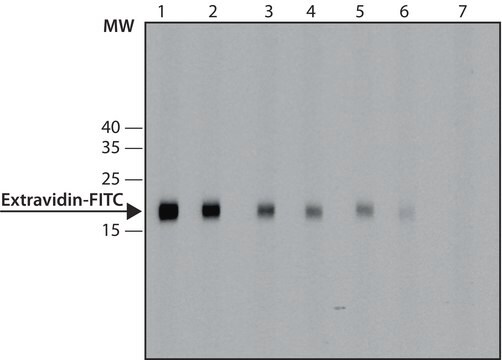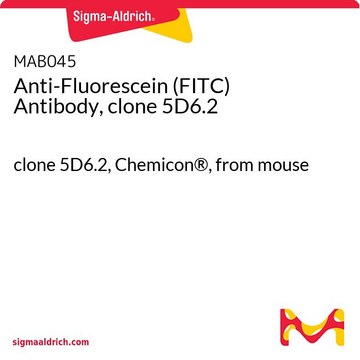SAB4600050
Monoclonal Anti-Fluorescein (FITC) IgG, CF™ 488A antibody produced in mouse
~2 mg/mL, clone 1F8.-1E4, purified immunoglobulin
Synonym(s):
Anti Fluorescein Antibody, Anti Fluorescein Antibody - Monoclonal Anti-Fluorescein (FITC) IgG, CF™488A antibody produced in mouse
About This Item
Recommended Products
biological source
mouse
Quality Level
conjugate
CF™ 488A conjugate
antibody form
purified immunoglobulin
antibody product type
primary antibodies
clone
1F8.-1E4, monoclonal
form
buffered aqueous solution
concentration
~2 mg/mL
technique(s)
indirect immunofluorescence: 1-10 μg/mL
isotype
IgG1κ
fluorescence
λex 490 nm; λem 515 nm
shipped in
dry ice
storage temp.
−20°C
target post-translational modification
unmodified
Related Categories
General description
Specificity
Immunogen
Application
Biochem/physiol Actions
CF™ dyes are a series of highly water-soluble fluorescent dyes, with wavelength extended over the visible and near-infrared (IR) spectrum for labeling biomolecules, mainly proteins and nucleic acids. The primary structure of the CF™ dyes is either cyanine dyes or rhodamine dyes. CF™ 633 produces the brightest antibody conjugates among spectrally similar dyes when excited by the 633nm He-Ne laser or the 635nm red diode laser. The most important advantage of CF™ 633 is its excellent photostability. The molecular weight of CF™ 633 is ~820 and its absorption/emission maxima are at 630/650nm.
Features and Benefits
Physical form
Preparation Note
Legal Information
Disclaimer
Not finding the right product?
Try our Product Selector Tool.
Storage Class
10 - Combustible liquids
wgk_germany
WGK 2
Choose from one of the most recent versions:
Certificates of Analysis (COA)
Don't see the Right Version?
If you require a particular version, you can look up a specific certificate by the Lot or Batch number.
Already Own This Product?
Find documentation for the products that you have recently purchased in the Document Library.
Customers Also Viewed
Our team of scientists has experience in all areas of research including Life Science, Material Science, Chemical Synthesis, Chromatography, Analytical and many others.
Contact Technical Service









